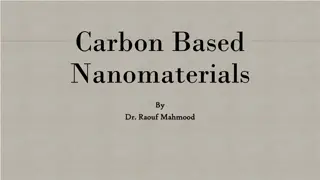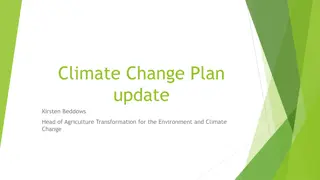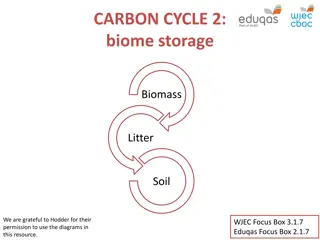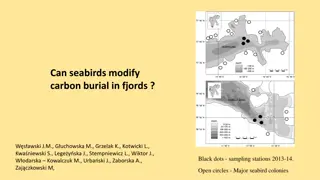Can Financial Engineering Help Save the Planet?
Explore the potential of financial engineering in combating climate change through carbon-linked bonds. Dive into the concept of scaling low carbon investments, optimizing portfolio allocations, and creating credibility using financial tools. Discover how the Carbon Barometer aggregates data to trac
0 views • 13 slides
Harnessing Carbon Markets for Sustainable Development in Pakistan
Understanding the significance of carbon markets, this content delves into the interplay between economic growth and environmental sustainability, emphasizing the urgency to limit unsustainable practices. It explores mechanisms such as carbon pricing and cap-and-trade systems in the context of clima
0 views • 17 slides
Carbon Pricing Overview and EU Green Deal Agenda
The overview of carbon pricing inside the EU highlights key aspects such as the EU Green Deal, revision of the EU ETS, and the Carbon Border Adjustment Mechanism. The EU aims for carbon neutrality by 2050 with a 55% reduction target. The Fit for 55 initiative emphasizes relevance for the Energy Comm
4 views • 16 slides
Ensuring Integrity in the Voluntary Carbon Market for a Just Transition
The voluntary carbon market plays a crucial role in achieving a just transition to 1.5°C, emphasizing high integrity standards. The ICVCM has set Core Carbon Principles to uphold quality standards for carbon credits, ensuring market integrity and participant eligibility. Key components include asse
1 views • 18 slides
Overview of California's Carbon Removal Initiatives
California's Carbon Removal Innovation Support Program (CRISP) aims to incentivize Direct Air Capture (DAC) development in the state. The program includes research test centers, small-scale demonstrations of DAC technologies, community engagement, technical assistance, and more to enhance carbon rem
0 views • 5 slides
Understanding the Carbon Cycle: Reservoirs, Dynamics, and Importance
Earth's carbon cycle plays a crucial role in sustaining life, with carbon moving through various reservoirs and processes. This cycle involves short-term terrestrial and marine cycles, as well as long-term cycles influenced by volcanic activity and rock weathering. Understanding carbon reservoir dyn
6 views • 45 slides
Embracing Sustainability: A Comprehensive Analysis of Carbon Neutral Farming
Carbon Neutral Farming Market, also known as carbon farming or climate-smart agriculture, focuses on reducing greenhouse gas emissions and sequestering carbon in soils and vegetation.
3 views • 2 slides
Manufacturer and Exporter of ASTM A105 Carbon Steel Flanges in Mumbai, India
Premium Quality Carbon Steel ASTM A105 Flanges, Carbon Steel A105N Slip On Flanges, Weld Neck Flanges, Blind Flanges, Socket Weld Flanges, Ring Type Joint Flanges etc. ASTM A105 Flanges. ANSI B16.5 Carbon Steel A105 Pipe Flanges Suppliers in Mumbai, India.
0 views • 5 slides
Manufacturer and Exporter of ASTM A105 Carbon Steel Flanges in Mumbai, India
Premium Quality Carbon Steel ASTM A105 Flanges, Carbon Steel A105N Slip On Flanges, Weld Neck Flanges, Blind Flanges, Socket Weld Flanges, Ring Type Joint Flanges etc. ASTM A105 Flanges. ANSI B16.5 Carbon Steel A105 Pipe Flanges Suppliers in Mumbai, India.
1 views • 5 slides
carbon-steel-flange-manufacturer-exporter-in-dubai Manufacturer & Exporter
Metalloys Inte\u00adrnational is a leading Manufacturer & Exporter in Dubai, is known for producing Carbon Steel Flange\u00ads. Our team of industry professionals use pre\u00admium materials and advanced machinery to cre\u00adate Carbon Steel Flange\u00ads. These flanges, made\u00ad according to AST
1 views • 5 slides
CARBON STEEL FLANGE MANUFACTURER IN UAE
Metalloys Inte\u00adrnational is a leading Manufacturer & Exporter in UAE, is known for producing Carbon Steel Flange\u00ads. Our team of industry professionals use pre\u00admium materials and advanced machinery to cre\u00adate Carbon Steel Flange\u00ads. These flanges, made\u00ad according to ASTM
2 views • 5 slides
Activated Carbon Market Grows with Rising Demand
Activated Carbon Market By Type (Granulated Activated Carbon, Powdered Activated Carbon, and Others), By Form (Gas Phase and Liquid Phase), By End-Use (Air Purification, Food & Beverage Processing, Water Treatment, Pharmaceutical & Medical, and Other
0 views • 3 slides
Understanding Carbon-Based Nanomaterials and Their Technical Applications
Carbon-based nanomaterials, including fullerenes and carbon nanotubes, have revolutionized various industries with their unique properties. These materials, classified based on their geometrical structure, have applications in fields such as electronics, gas storage, biotechnology, and more. Fullere
0 views • 12 slides
Tracing Carbon Atoms in Ecosystems: Understanding the Organic Matter Pyramid
Explore the journey of 500 carbon atoms through producers, herbivores, and carnivores in an ecosystem. Discover how carbon atoms move through photosynthesis, cellular respiration, and biosynthesis, ultimately contributing to the organic matter pyramid. Follow the pathways of carbon atoms as they cyc
0 views • 7 slides
Carbon Sequestration: A Comprehensive Overview
Explore a thorough overview of Carbon Capture and Storage (CCS) covering key projects, global CCS capacity, value chain processes, project development stages, and site selection criteria. Learn about the significant role of CCS in mitigating industrial and power emissions, contributing to sustainabl
0 views • 19 slides
Understanding the Carbon Cycle and Its Impact
Explore the intricacies of the carbon cycle, the fundamental building block of life, and the five spheres of Earth involved in this crucial process. Learn about carbon sources and sinks, its role in chemical processes, and its significance in the Earth's energy balance. Discover key points about the
0 views • 10 slides
Importance of Carbon Calculators in Deep Foundation and Ground Improvement Works
Climate change concerns have elevated the need for assessing carbon footprints. The EFFC/FPS members must account for carbon emissions to understand impacts, reduce energy dependence, quantify innovative techniques, and showcase environmental advantages. The introduction of a carbon calculator tool
0 views • 26 slides
Understanding Fossil Fuels and Pollution: A Comprehensive Overview
Fossil fuels such as coal, oil, and natural gas are non-renewable energy sources that release heat energy when burned, but also contribute to pollution when not burned completely. This leads to the release of harmful pollutants like carbon dioxide, carbon monoxide, sulfur dioxide, and carbon particu
2 views • 9 slides
Understanding the Carbon Scenario Tool for Climate Change Management
The Carbon Scenario Tool (CST) is a valuable resource developed by the University of Edinburgh and the Scottish Funding Council to manage, report, and forecast carbon emissions for university estates and operations. It enables the calculation of the impact of carbon reduction projects and the develo
2 views • 18 slides
Understanding Carbon Movement in the Environment
Explore the intricate processes of carbon movement in the biosphere, atmosphere, oceans, and geosphere. Learn how plants absorb carbon dioxide, animals utilize carbon for tissue building, and the impacts of human activities like burning fossil fuels on carbon distribution. Discover the critical role
0 views • 6 slides
Transforming Agriculture for Climate Change: Kirsten Beddows' Vision
Kirsten Beddows, Head of Agriculture Transformation, shares an updated Climate Change Plan focused on reducing emissions, achieving net-zero by 2045, and creating sustainable farming practices. The plan includes over a hundred new policies targeting emissions reduction, land use optimization, and ca
0 views • 9 slides
Understanding the Biological Pump and Carbon Cycle in the Ocean
The biological pump in the ocean involves photosynthesis by phytoplankton, which removes carbon dioxide from the atmosphere, and respiration, where some CO2 is released back. Phytoplankton are crucial in the ocean's carbon cycle, with primary consumers like zooplankton depending on them for energy.
0 views • 20 slides
Understanding Organic Chemistry: Carbon Atoms and Molecular Diversity
In organic chemistry, carbon atoms can form diverse molecules by bonding to four other atoms, leading to molecular complexity and diversity. The versatile nature of carbon allows for the formation of various carbon skeletons, contributing to the vast array of organic compounds. Hydrocarbons, consist
0 views • 12 slides
Innovative CPC Futures Contract Program for Agribusiness Sustainability
The Commodity Plus Carbon (CPC) Futures Contract Program integrates agricultural commodity prices with carbon valuation to incentivize good agricultural practices and reduce carbon footprint. By combining ag commodity prices with carbon reductions, CPC contracts offer hedging opportunities and incen
0 views • 8 slides
Enhancing Emissions Reduction and Carbon Sequestration in Forests
This presentation discusses the importance of implementing mitigation strategies in forests to reduce emissions and enhance carbon removal. It highlights the benefits of intact/restored ecosystems, carbon sequestration as an ecosystem service, and the carbon stocks in tropical forests. The focus is
1 views • 21 slides
Understanding Carbon Capture Solutions for Combatting Climate Change
Delve into the world of carbon capture and sequestration (CCS) as a pivotal technology in achieving carbon-free electricity generation goals by 2045. Explore the importance of natural and technological CCS options, alongside solutions such as energy efficiency, renewable energy, and more, to address
0 views • 14 slides
Overview of Carbon Accounting in the UK: Progress and Challenges
The project aims to test the feasibility of producing SEE-EEA style Carbon Accounts, assess data sources, and lay a path for further development. Carbon accounting in SEE-EEA identifies carbon as a key theme, supporting ecosystem measurement. The UK's carbon accounts cover geosphere, biosphere, ocea
0 views • 15 slides
Understanding Carbon Storage in Biomes and Ecosystems
Explore the intricate carbon cycle within terrestrial ecosystems, focusing on carbon storage in biomass, litter, and soil. Delve into the differences in plant characteristics among various biomes and their impact on carbon sequestration. Gain insights into the distribution of tropical rainforests an
0 views • 13 slides
Integrated Terrestrial-Coastal Ocean Framework for Carbon Management
An advanced framework integrating terrestrial and coastal ocean observations and modeling is developed to support carbon management decisions. The study focuses on assessing the impacts of land use, human activities, and climate scenarios on the carbon cycle, particularly dissolved inorganic carbon
0 views • 5 slides
Evaluating Maquoketa Group for CO2 Sequestration in Illinois Basin
Study examines the Ordovician Maquoketa Group's potential as a seal for CO2 geologic sequestration in the Illinois Basin. The project background, methodology, results, and conclusions highlight the importance of the CarbonSAFE Initiative in developing storage sites for carbon dioxide from industrial
0 views • 20 slides
Strategies for Climate Remediation and Geoengineering
Explore various methods for addressing climate change through CO2 removal and sequestration, considering the social cost of carbon and the potential of lumber farming, while also discussing alternative processes like algae cultivation and ocean liming. Crazy ideas such as industrial processes for ca
0 views • 13 slides
Achieving UK Net-Zero: Strategies for Carbon Capture and Low-Carbon Fuels
Explore the pathways to achieving UK net-zero carbon emissions through carbon capture, low-carbon alternative fuels like hydrogen and bioenergy, and sustainable bioenergy practices. Learn about the importance of zero-carbon hydrogen production and the challenges and benefits of utilizing bioenergy f
0 views • 12 slides
Greenhouse Gas Rulemaking and Standards Overview
This information provides an overview of the US EPA's new final carbon standards for fossil-fuel-fired power plants, including the impact on electric generation in Kentucky and the state plan required for compliance. It discusses the repeal of the Affordable Clean Energy Rule, compliance guidelines
0 views • 10 slides
Understanding Peatlands and Carbon Storage in the Carbon Cycle
Peatlands are vital landscapes where peat accumulates, storing large amounts of carbon. Learn about peat formation, anaerobic conditions, different types of peatlands, and the significant role peatlands play in carbon storage globally. Explore the link between water cycle and peat formation, emphasi
0 views • 12 slides
Mapping Soil Organic Carbon Fractions in Australia: Stocks and Uncertainty
This study by Mercedes Román Dobarco et al. focuses on mapping soil organic carbon fractions across Australia, including mineral-associated organic carbon, particulate organic carbon, and pyrogenic organic carbon. The research involves prediction of soil organic carbon fractions using spectral libr
0 views • 17 slides
Carbon Forestry and Poverty Alleviation: The Case of REDD in Nigeria
Global carbon forestry programs like REDD aim to alleviate poverty but face challenges in empowering forest-dependent communities. The paper discusses the role of key actors in maintaining the status quo, presenting research findings from a REDD program in Nigeria. Carbon forestry involves market-ba
0 views • 15 slides
Insights from Orbiting Carbon Observatory-2 (OCO-2) on Global Carbon Cycle
Orbiting Carbon Observatory-2 (OCO-2) offers precise measurements to understand sources and sinks of CO2 in the atmosphere, providing valuable data on carbon uptake by plants and global carbon emissions. OCO-2's findings shed light on the impact of extreme climate events like droughts and fires on t
0 views • 8 slides
Managing Farmland Nitrogen Emissions: Strategies and Research Updates
Soils play a crucial role in greenhouse gas emissions and carbon sequestration. Karl Richards, Head of Soils, Environment & Land-Use Department at Teagasc, discusses the importance of managing farmland nitrogen emissions through various practices. Research focuses on reducing emissions and enhancing
0 views • 8 slides
Carbon Modification by Seabirds in Fjords: Implications and Patterns
The study investigates the impact of seabirds on carbon burial in fjords, showcasing factors such as wind stress patterns, terrestrial vegetation biomass, and various carbon sources in the ecosystem. It delves into the distribution and fate of carbon in two fjords, Hornsund and Kongsfjorden, sheddin
0 views • 7 slides
Understanding the Carbon Cycle: System Concepts and Pathways
The carbon cycle involves the movement of carbon between different stores in the global system, such as the atmosphere, oceans, and biosphere. Flows, inputs, and outputs play crucial roles in this cycle, with processes like photosynthesis and respiration impacting carbon levels. Explore how mass bal
0 views • 13 slides







































